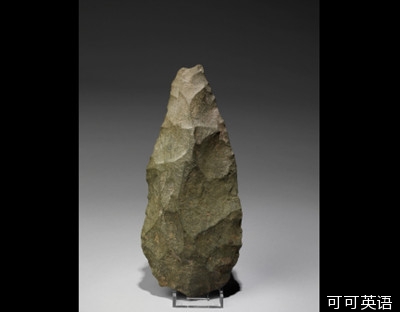'Now, if I really wanted to refine that - and people did want to refine that, they really were creative people; they wanted to make beautiful objects, not just functional objects - what I could then do is change the hammer from a big stone hammer to a hammer that is much softer ... a piece of antler is a perfect hammer. And what we would do then, is actually thin the piece down and refine the shape, work our way round ... and in about 10 to 15 minutes, there's your handaxe.'
“現在,假設我真想進行精加工——其實早期人類還真想要精加工,他們可堪稱是創意人,想要制造的有美感的物品,不僅僅只是功能性的物品。總之呢,我現在得做的是,收起這把大石錘,換一更加小巧、硬度低點的錘子,挑塊鹿角當錘子就很合適了。接下來我們就把這里細細削薄,沿著邊緣一圈削下來……這樣加工上大概十到十五分鐘,你的手斧就出來了。”菲爾·哈丁解釋道。
But as well as great manual dexterity, what's important for our story is the conceptual leap required - to be able to imagine in the rough lump of stone the shape that you want to make, in the way a sculptor today can see the statue inside the block of marble.
然而且不談這工藝如何之精湛,我們故事中的重點是其中所需的概念性飛躍,即能夠從粗糙的石頭疙瘩里面想像出你所想要制造的工具形狀,正如當代的雕塑家可以從大理石塊中構思出成型的雕像一樣。
This particular piece of supreme hi-tech stone is between 1.2 and 1.4 million years old. Like the chopping tool we were looking at in the last programme, it was found in East Africa, at Olduvai Gorge, that great split in the savannah in Tanzania.
這件特別的精巧高技術石器大約有120至140萬歲了。正如我們上集節目中介紹的那件石制砍砸器,這石斧也出土于東非的奧杜威峽谷那道坦桑尼亞大草原上的大裂縫。
But this comes from a higher geological layer than the chopping tool, and there's a huge leap between those earliest first stone tools and this handaxe, because I think it's in this tool that we find the real beginnings of modern humans. The person that made this is, I think, a person we would have recognised as someone like us.
但這石斧出土的地質層比那砍砸器更晚一些,而且兩者之間存在著最大的質的飛躍,因為我覺得這石斧才正是現代人類的真正開端。我想我們會認同制造這件物品的那個人與我們是同樣的人類。
All this carefully focussed and planned creativity implies an enormous advance in how our ancestors saw the world and how their brains worked. But this handaxe may contain the evidence of something even more remarkable. Does this chipped stone tool hold the secret of speech? Was it in making things like this that we learned how to talk to one another?
諸如此類的井井有條、構思完善的創造力,意思味著我們祖先在看待世界與其自身的大腦運上都有了長足的進步。然而這塊石斧可能也蘊藏著其他更加不可尋常的證據。這塊打制石器是否隱藏著語言的秘密?我們是否在制作類似這樣工具時學會了彼此用語言交流?
Recently, scientists have looked at what happens inside the brain when a stone tool is being made. They've used modern hospital scanners to see which bits of the brain are used when a knapper is working with stone - and surprisingly the areas of the modern brain activated when you're making a handaxe overlap considerably with those you use when you speak. It now seems very likely that if you can shape a stone you can shape a sentence.
近來科學家研究了制造工具的過程人類大腦中的活動情況。他們采用現代醫學掃瞄儀來觀察當石匠加工石器時,大腦的哪部分會被使用到。令人驚訝的是,當時進石器制作時現代人大腦活動區域與使用語言時大腦活動區域有相當大的一部分是重疊的。現在看來極有可能當你有能力加工一塊石頭,你就有能力加工一個句子。












